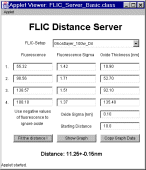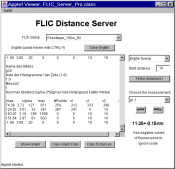| Choose one of the FLIC Simulations below! | |||
 |
 |
||
|
for 4 oxides |
professional |
||
FLIC is the acronym of Fluorescence Interference-Contrast. When measuring fluorescent dyes in close contact to a reflecting surface, the fluorescent intensity becomes a function of the distance to the surface. As the reflecting surface behaves like a mirror, both exciting and emitting light become standing waves with knots at the surface.
This effect can be measured in a microscope with fluorescent dyes prepared on transparent steps of different height. In our case, we used silicon dioxide on silicon chips. With steps smaller than the cells it was possible to measure cell substrate distances with very high precision.
We offer here on the left side two demo applets to play with the main
FLIC parameters. We also have installed a distance server with precalculated
optical setup to fit from your fluorescence intensities and the chips'
oxide thicknesses the distance online. If you want to do FLIC measurements,
please contact Prof. Fromherz.
| Choose one of the FLIC Simulations below! | |||
 |
 |
||
|
for 4 oxides |
professional |
||
Fluorescence
Interference-Contrast Microscopy on Oxidized Silicon using a Monomolecular
Dye Layer.
A. Lambacher, P. Fromherz, Appl.Physics A 63 (1996) 207-216
Fluorescence
Interference-Contrast Microscopy of Cell Adhesion on Oxidized Silicon.
D. Braun, P. Fromherz, Appl.Physics A, 65 (1997) 341-348
Fluorescence
Interferometry of Neuronal Cell Adhesion on Microstructured Silicon.
D. Braun, P. Fromherz, Phys.Rev.Lett. 81 (1998) 5241-5244